Crafting your very own homemade seitan is super easy. This step-by-step tutorial will show you how to make seitan with vital wheat gluten and a few pantry staples! Plus: a recipe for homemade seitan with three flavor variations.
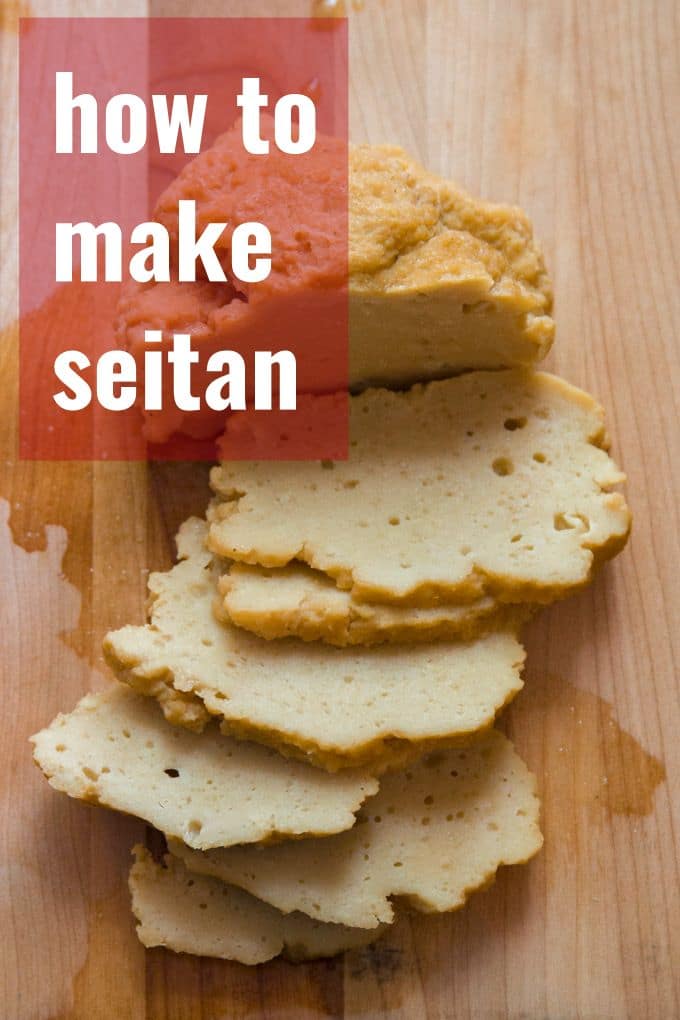
Early on in my blogging days I posted a recipe for seitan. Just recently I set out to make some updates to that post, namely, rephotographing it, when I realized something more was needed.
A recipe is what kept me from making seitan for about ten years. I'll explain what I mean below, but for now, suffice it to say, seitan is more of a how-to, choose your own adventure type food. Seitan is super easy to make with the ingredients that are readily available these days, and once you've made a few batches you can totally wing it.
I first heard about seitan when I was about nineteen. I was a big fan of the show Christina Cooks with the Class. I loved that show! Ate up all of her seemingly crazy veggie concoctions, literally. One day she busted out some seitan, and I was intrigued, to say the least. I eventually got my hands on some, and later branched out into making my own seitan.
My first experiences with homemade seitan involved following a recipe that called for rinsing and massaging a big ball of wheat flour dough for a half hour or so to isolate the wheat gluten, which was a huge pain in the butt. This was before powdered vital wheat gluten became widely available.
That recipe also involved a big piece of kelp known as kombu, which was meant to give the seitan a savory flavor. The recipe instructed me to use kombu, so I dutifully searched every Asian market within a few city blocks until I found some.
After that I didn't make seitan again for a while because (1) the whole dough rinsing process was just way to daunting, and (2) I didn't feel like searching for kombu again.
I totally had it in my head that kombu was essential to seitan making. In my defense, the cookbook I'd been using, which was probably written in 1972, acted like kombu was the biggest deal ever and without it your seitan would be awful.
I know better now, and this is why I'm giving you a recipe today with three flavor variations.
Also, you don't even have to follow the recipe. Read my instructions below and make seitan your way. The only essential ingredient is the vital wheat gluten, which, thankfully, you can get at natural foods stores and some regular old supermarkets these days.
Jump to:
Seitan Basics
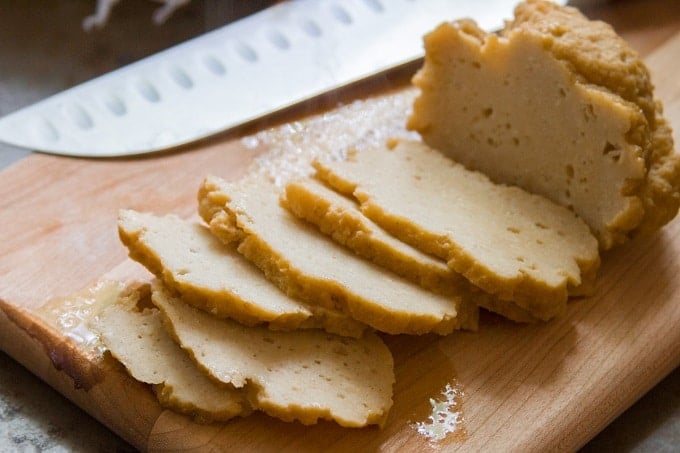
Let's back up! Perhaps you've never heard of seitan before and am wondering what on earth I'm talking about.
Seitan is a meat substitute that's made from seasoned wheat gluten.
Yes, you read that right: seitan is made from wheat gluten. And that might be why it scares people. But if you don't have celiac disease and you're not gluten sensitive, there's nothing to worry about.
Wheat gluten is the protein found in wheat. It has a very meaty texture, so and when you add some meaty flavors it's the perfect vegan meat alternative in all sorts of recipes — I use seitan in everything from stir-fries to stews to sandwich fillings. It also packs a whopping 25 grams of protein per 4 ounce serving.
You may have even had seitan before without realizing it.
If you've ever eaten a vegetarian restaurant meal and were amazed at how meaty it tasted, you were probably eating seitan. If you've ever eaten commercial meat substitutes, they probably contained some seitan.
I don't eat a whole lot of store-bought meat substitutes though. I prefer homemade seitan because it's generally a lot better, and I know what's in it.
How It's Made
The following is a detailed photo tutorial on how to make this dish. Scroll all the way down if you'd like to skip right to the recipe!
Though there are many ways to make seitan, the method described below is what I consider to be the simplest. We'll be making a simple gluten-based dough and simmering it in broth.
Other methods for making seitan include the washed flour method, where you start with whole wheat flour instead of vital wheat gluten, then rinse the flour to remove the bran and starch. There are also methods including baking and/or steaming your dough, like I've done in my vegan pepperoni recipe.
1. Make the Dough
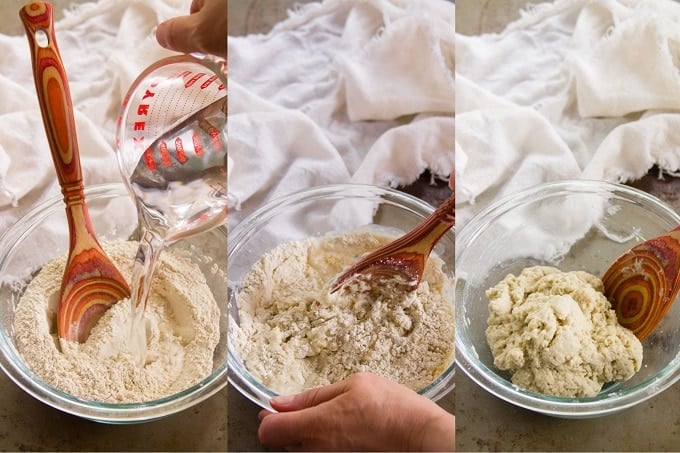
As you might have guessed, the dough starts with vital wheat gluten, which will be in powdered form. You can cut the gluten with another type of flour. I like to do this — I find gluten alone results in seitan that's a bit tough for my taste.
1 cup of vital wheat gluten to ¼ cup chickpea flour or soy flour is a good place to start. This will give you about 2 cups of seitan. Stir them together in a large bowl.
Add water. 1 cup is a good amount for the batch size we're working with. Mix and form a dough.
2. Knead the Dough
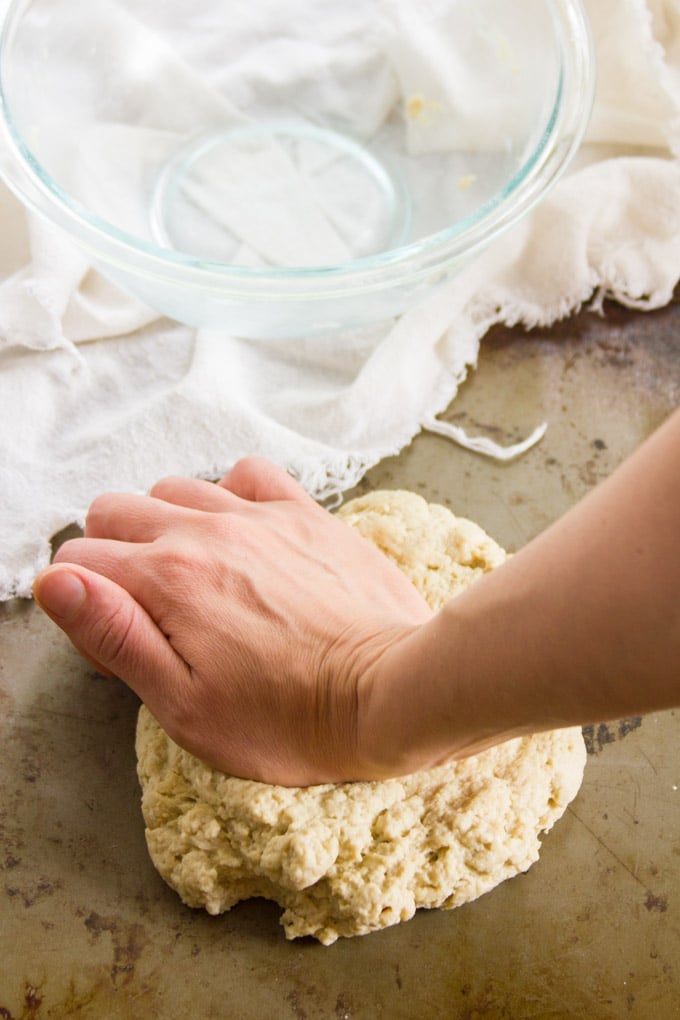
Just like with bread making, we need to knead the dough a bit, to develop strands of gluten that give seitan a meaty texture.
About 5 minutes of kneading is sufficient. Let it sit for about 5 minutes after that.
3. Make the Broth
The broth is what gives your seitan flavor, so you want it to taste how you intend for your seitan to taste. You can do whatever you want here, and this is a great place to experiment. Feel like searching every local Asian market for a big piece of kombu? Totally fine, but if you can't find one, please don't let it stop you!
For the batch size we're going with, six cups of broth is about ideal. If you take a look at the amount of dough you've got, six cups may seem like a lot, but it's not. Your seitan will double or even triple in size while it cooks!
I usually start with low sodium vegetable broth, but water works too. You'll want a good amount of salt in there (meat is salty!), which is best provided by soy sauce, tamari, or liquid aminos. ¼ to ⅓ cup of soy sauce is my standard.
From there, it's all up to you what you add. Think savory flavors. Here are a few suggestions:
- garlic (fresh or powder)
- onion powder
- dried herbs
- wine
- nutritional yeast
- vegan Worcestershire sauce
- miso
(this adds quite a bit of salt, so use less soy sauce if you include it)
- liquid smoke
- Kitchen Bouquet, Gravy Master, or another all-purpose seasoning
If you're not sure where to start, use the recipe below. If has three broth variations for seitan that's best suited to replace different types of meat: pork, chicken, and beef.
4. Simmer
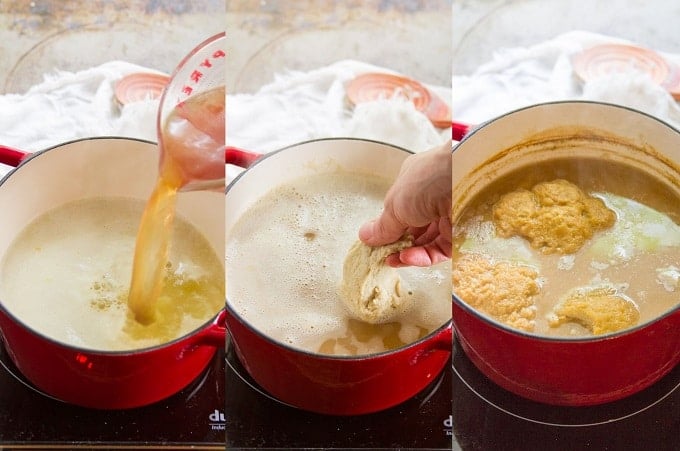
By the time your broth is done, your seitan dough should be sufficiently rested. Cut it into smaller pieces. I recommend cutting it into at least 4 pieces because (1) if they're too big the broth won't fully penetrate them, and (2) remember that they'll expand during cooking, and if they get too big the broth will no longer cover them.
Tip: The smaller you cut your dough pieces, the more broth penetration you'll get, giving you more flavorful seitan.
Bring the broth to a boil. Lower the heat until it's just at a simmer, and then add the dough pieces. Set the timer for an hour and keep an eye on the pot. You don't want to let it get to a rolling boil, or your seitan might end up overcooked and chewy. I like to keep mine just barely simmering.
Once it's finished simmering, your seitan is ready to be eaten or used!
Shelf-Life & Storage
Store your homemade seitan in the cooking broth, in an airtight container. It will keep in the fridge for about five days, or in the freezer for about three months.
How to Cook with Seitan
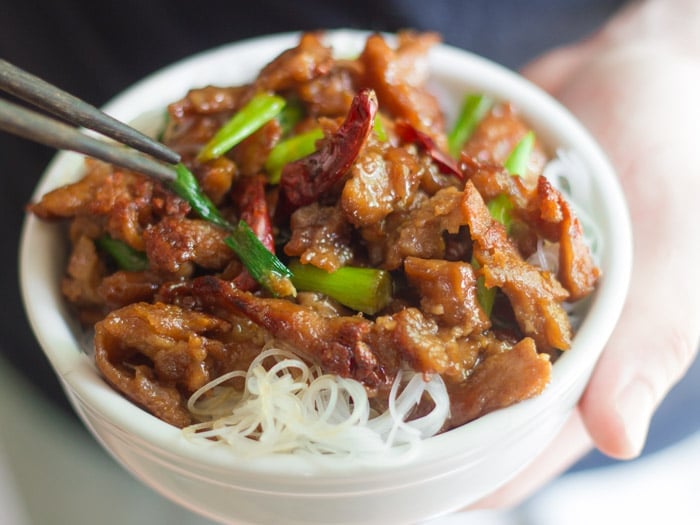
Technically, your seitan is already cooked and you can eat it straight from the pot — I often do!
But you probably want to incorporate it into a dish.
Seitan can be directly substituted for meat in many recipes. Look for recipes that call for distinct pieces or slices of meat. Stir-fries, kebabs and stews are great for using big chunks of seitan. Sliced seitan can be used in sandwiches. I've even finely chopped seitan and used it as a substitute for ground beef.
Seitan lends itself to baking, frying, pan-frying, stir-frying, grilling, simmering and steaming, among many other cooking methods.
I've provided three flavors in the recipe card below: beef, pork and chicken. It's usually best to choose the variation that's closest to the variety of meat your recipe calls for.
From there, it's just a matter of directly substituting seitan for meat in the recipe. The only modification you might need to make is to the cook time. You don't need to worry about seitan cooking all the way through or to a specific temperature like you might with meat, so the cook time in many recipes can be shortened.
Read my article on how to cook with seitan if you need more guidance.
You can also try one of my seitan recipes. I've listed a few favorites just above the recipe card at the bottom of this post.
Frequently Asked Questions
Many grocery stores carry packaged seitan in the natural foods aisle. Look for brands like WestSoy, Upton's Naturals and Franklin Farms. If your regular supermarket doesn't have it, try a place like Whole Foods.
Yes! You can use it to make another (smaller) batch of seitan if you'd like. You can also add it to recipes like soups, stews and gravies.
Sure you can! I'd encourage you to first make one of the recipe variations below to get familiar with the process, but experiment to your heart's content after that, adding seasonings to both the dough and broth.
Usually this happens when you let the broth boil too rapidly, which leads to rapid expansion of trapped air within the dough, totally messing up the texture of your seitan. Keep it at a super low simmer, so it's barely bubbling.
Unfortunately, no. Since gluten is the main ingredient in seitan, it really can't be done. I've found that Butler Soy Curls are a great gluten-free option that work in place of seitan in many recipes. Also check out my two other favorite plant-based protein ingredients, tofu and tempeh, both of which are gluten-free.
Seitan Recipes
I also created an entire round-up post of seitan recipes if you need some more inspiration!
Like this recipe? If so, please stop back and leave me a review and rating below if you try it! Also be sure to follow me on Facebook, Pinterest or Instagram, or subscribe to my newsletter for more recipes like this one!
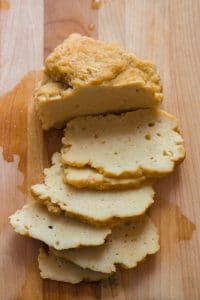
Homemade Seitan
Crafting your very own homemade seitan is super easy, and you don't even need a recipe. This step-by-step tutorial will show you how to make seitan with vital wheat gluten and a few pantry staples! Plus: a recipe for homemade seitan with three flavor variations.
Ingredients
For the Dough
- 1 cup vital wheat gluten
- ¼ cup chickpea flour
- 1 cup water
For the Broth - Pork Flavor
- 6 cups low sodium vegetable broth or water
- ⅓ cup soy sauce
- 2 tablespoons maple syrup
- 2 tablespoons apple cider vinegar
- 2 teaspoons liquid smoke
- 2 teaspoons smoked paprika
- 1 teaspoon onion powder
- 1 teaspoon garlic powder
For the Broth - Chicken Flavor
- 6 cups low sodium vegetable broth
- ⅓ cup soy sauce
- ¼ cup nutritional yeast flakes
- 1 ½ teaspoons white wine vinegar
- 1 ½ teaspoons poultry seasoning
- 1 teaspoon onion powder
- ½ teaspoon garlic powder
- ½ teaspoon liquid smoke
For the Broth - Beef Flavor
- 5 ½ cups low sodium vegetable broth
- ½ cup dry red wine
- ⅓ cup soy sauce
- 2 tablespoons vegan Worcestershire sauce
- 1 teaspoon dried thyme
- ½ teaspoon onion powder
- ½ teaspoon garlic powder
- ½ teaspoon black pepper
Instructions
-
Stir the vital wheat gluten and chickpea flour together in a medium bowl.
-
Add the water and stir to form a soft dough.
-
Transfer the dough to a work surface and knead it for 5 minutes.
-
Allow the dough to rest for 5 minutes.
-
While the dough rests, stir all of the broth ingredients for your choice of broth together in a large pot.
-
Place the pot over high heat and bring the mixture to a boil. Lower the heat to a low simmer.
-
Cut the dough into at least 4 large pieces, or if you prefer, smaller strips or chunks.
-
Add the dough to the broth.
-
Allow the broth to simmer for 1 hour, uncovered, watching closely to ensure it stays at a low simmer (don't allow it to rapidly boil).
-
Remove the pot from heat and allow it to cool a bit.
-
When the seitan is cool enough to handle, you can cut it into smaller pieces if you like. Use it in a recipe immediately, or store it in the broth. Refrigerate for up to 5 days, or freeze.
Recipe Notes
The nutrition information is very approximate for this recipe, since there are three flavor variations and it's difficult to estimate just how much broth is absorbed during cooking.


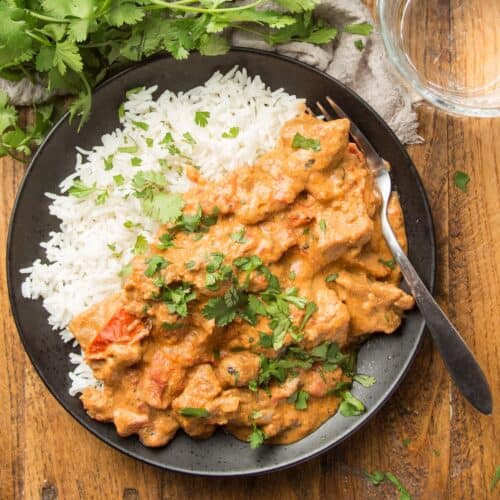
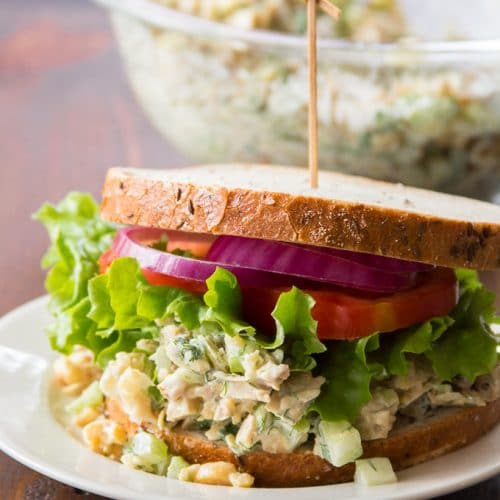

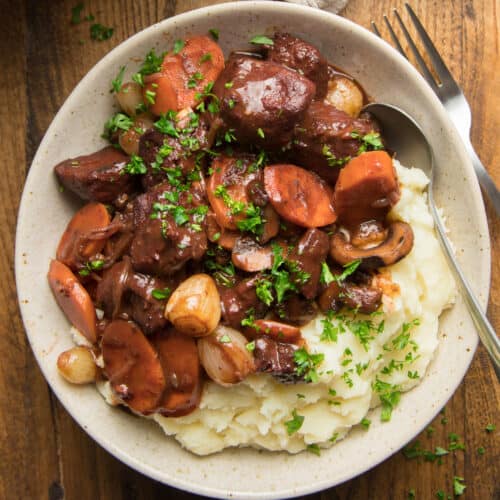
Ohhh Emmmm Geeee I wish I could give this recipe 10 stars!! I’ve been plant-based for almost 5 years and never tried making seitan before because I thought it was difficult and finicky. I looked at several recipes and chose yours because it was the simplest and I’ve made several of your recipes before! But to be 100% honest I was skeptical that it would turn out right especially when mine didn’t increase in size. I just knew it was going to be tough and I feared it would be spongy. But it was neither and the flavor is delicious and the texture and “bite” are divine! I made my own vegetable stock which had a lot of flavor and combined with your broth ingredients it’s amazing. The flavor is primarily on the outside but this is perfect because I want to make several dishes out of it. When I make it again I may add the broth to the dough as others’ have suggested, depending on how I’m going to use it.
Thank you for helping me get over my fear of making seitan! Excellent recipe.
I just made this, and it was ridiculously easy. I've been wanting to make some ever since I went vegan. A friend of mine (also vegan) told me not to bother, because seitan was too difficult, and she had a batch explode in her oven. (!!) I put together the broth and started it heating before making the seitan. By the time I finished mixing, kneading and resting, the broth was already simmering. I made the "chicken" version this weekend, and it turned out delicious, and beautifully textured. Great recipe -- thank you!
Hola, me gustaron tus recetas, podrías enviarme más a mi correo? Gracias, en verdad muchas gracias
¡Me alegra que los estés disfrutando! Aquí hay un enlace a la página donde puede suscribirse a mi lista de correo electrónico: https://www.subscribepage.com/connoisseurusveg
Hi Alyssa. Recipe looks great but haven’t made it yet. Regarding nutritional info, sodium quantity high , so is this for the entire slab of seitan, or an individual serving the size or weight of which is not indicated.
Thanks, Shirley Fraser
The nutrition info is for a serving, which is about one fourth of the batch - about 3 ounces, though the exact weight will vary from batch to batch.
Made this tonight for Valentine's Day feast. I made broth with veggie scraps, lots of mushroomy flavor. I chunked the seitan and stretched it in an attempt to get strips. I removed from broth, drained, squeezed and dried thoroughly, then tossed in cornstarch and spices, and fried in olive oil. Yes ma'am, so good. My seitan had the appearance of chicken nuggets--no complaints here, but I may try to roll the dough into a loaf next time and slice into strips before simmering. Great recipe!
I'm reserving the braising liquid because it smelled so good. How long will this keep if sealed in the fridge?
It should be good for about 5 days in the fridge. You can also freeze it for up to 3 months. I like adding mine to soups and stews!
I plan to fry the seitan. Is it safe to eat the dough after frying or do i need to boil it for an hour first before I fry it? Thanks
It should be safe to eat, but I'm not sure if the texture will be right. I'd boil it and then fry it - I'd done this before with great results!
I've just tried this recipe for the 1st time. I left the lid on (didn't read instructions properly) Seitan didn't expand - quite ap dense texture but am still going to try and make something out of it tomorrow- wish me luck 🤞🏻
I’m new to this and I’ve noticed most seitan recipes call for chickpea flour. Can you use regular flour, what is the difference?
The texture and flavor will be different, but I've had some readers tell me that this does work with all-purpose flour.
I always make it with regular flour, and it comes out great. Best Seitan recipe I've found. I usually add some seasoning (like Trader Joe's Mushroom Umami blend) to the dough, but otherwise follow the recipes as given. Works every time.
I'd use the chickpea flour. Trader Joe's used to have the only decent, actually delicious, chickenless "chickn" on the market, and it contained chickpea flour. It was in big chunks that looked like shredded breast. They discontinued it a few years ago and left me bereft, LOL!. Not because if wasn't selling, it sold well, but because whatever brand-name company was making it for them to their specifications, couldn't make enough for TJ's. I miss it. I've tried every readymade brand, and they are either offensively salty and/or disgustingly greasy, in my opinion... one contains three kinds of starch, and two were literally sticky and mushy and tasted nothing like chicken, had no "bite," either. One was preformed, molded into uniform sticks and would squish against the roof of my mouth with just my tongue.
I've been meaning to make my own since TJ discontinued. To get the texture, I think chickpea flour would imitate TJ's chickn best. Alissa's is a good basic seitan recipe, I've seen all kinds online, from the most complicated end of the spectrum, to bizarre, or calling for ingredients that can't be located anywhere, and one that said you can't make decent seitan without using lots of lab chemicals. Alissa's recipes are going to turn out good basic seitan, and you can personalize it.
I've got five seitan cookbooks out from the library that I've been leafing through. The basics are always the same, though some recipes go to greater lengths to imitate the appearance of meats... red-and-pale streaked bacon, toothy spicy pepperoni, red beef, "fatty" layered pastrami, sticky ribs, and so on. For company I might go the distance, but for me by myself, I think this is all I need in the beginning. The flavor profile and the tooth-feel.
I'd follow her instructions and get a feeling for it. I've always known it has to be simmered for an hour before I do anything else with it, that's what I did when I was a hippie The only tips I'd give, after watching lots of YouTube videos... is never use nonstick cookware, especially older pots, they're unhealthy; and once you decide you like making seitan, buy ingredients like the nutritional yeast in a larger (1-lb) bulk amount, saving money. They are buying known brands and just repackaging them with their store name, for less. Nutritional yeast can be used with cashews to make vegan Parmesan... I sprinkle it over airpopped popcorn with avo oil and sea salt... and it's a daily-used condiment for my dinners, right next to the pepper and sea salt. So it makes sense to buy something more than a small brand-name plastic jar of it. I get nutritional yeast from Natural Grocers, and it's also sold in bulk bags at Sprouts.
I've been vegetarian since 1972. I really love tofu, but once in a while I want a change. It's only been a matter of time for me to finally try making my own seitan again. First chicken, then pepperoni. One would need to wrap the pepperoni log in parchment paper and then snugly in aluminum foil twisted at either end like a firecracker, to keep it dense. And she's not kidding about gently simmering: if you boil seitan it will swell into what I remember calling "brains!" LOL!
Alissa, thank you for your generosity and experience. I've mailed myself your recipe. I've always got the ingredients anyway. This is a good fundamental recipe, and you're the Real Deal. If I can wait for my sourdough each week, then I can use the same amount of time to make seitan. And if it's anything like TJ's was, I can freeze some. :)
Hi Alissa, I was just wondering if I could use all purpose flour instead of chickpea or soy? Thank you 😊
I've had a few readers tell me they did this with good results, so I think so!
Hi everyone!!!
First of all, Im new here, but would like to thank Alissa for the wonderful seitan recipe plus all the fantastic advice.
And of course to all the guests who have added their valued comments. Ive read them all!!!! Good stuff.
I followed Alissas recipe and it turned out fantastic, just what Ive been looking for, a tofu/quorn/paneer/soy substitute.
I live in Slovakia, and some ingredients are very difficult to purchase. So Ive used really close substitutes that work brilliantly.
So, I want to share a recipe with you that will absolutely blow you away!!!!!
I call it Chinese Seitan and its jaw droppingly good.
Seitan dough.
Same as alissas, but add 1 tsp crushed garlic and 1 tsp crushed ginger, 2 tbsp nutritional yeast, 1 heaped tsp Vegeta, or any salty mix, and 1 medium finely diced onion.
I find this really adds huge flavour to the basic seitan dough. Remember to mix all the ingredients together well, BEFORE you add the water. This will lock those ingredients inside the seitan.
Cook with Alissas chicken broth recipe.
Now comes the magical part!!!
Make up a Chinese marinade.
4 tbsp medium or dark soy sauce
4 tbsp honey
4 tbsp dry sherry, or 2 tbsp white vinegar and 2 tbsp chicken broth
1 tsp black pepper
1 tsp crushed garlic
1 tsp crushed ginger
1 tsp Chinese 5 spice or anise
1 tsp Vegeta or salty mix
4 tbsp tomato ketchup
half tsp chilli powder, mild or strong, depending on taste
half tsp garum masala
half tsp cumin powder
Mix all the ingredients together well. It should be a dark red colour, quite runny and smelling quite strong!!!!
Cut the cooked seitan dough into strips, maybe half inch square, 3 inches long
Place the marinade into a flat bottomed, sealable container
Add the strips of seitan until they are just above the marinade.
Seal container and marinate in fridge for 6 hours, shaking occasionally.
Remove strips from marinade and either grill or lightly fry with oil, until light brown or even charred!
Serve on a bed of fresh sliced seasonal raw vegetables, I normally use lettuce, cucumber, tomatoes, peppers, etc.
Trust me, it is amazing!!!!!
P.S. For the liquid smoke used in the original Alissas broth, you can substitute for 1 tsp smoked paprika powder.
Excellent! I used this recipe to make mock duck. I'm a home chef with tons of experience who just went vegetarian (sorry, I have to have real cheese), but was a bit wary. This is easily as good as you can get at any vegetarian/vegan restaurant. I can't wait to try all the versions.
Super good! I made the beef version twice. The first time was a little too acidic for me but I might not be a big fan of worcestershire sauce. Def will make again. Super perfect.
Simple and delicious, this! I've tried other recipes, yet this one is by far the best because it's so simple. With this, I can experiment to my heart's desire. In school, they fed us vegan hamburgers, and I loved them. This recipe takes me back a bit. I plan on experimenting with one "hamburger" after another!
Followed the recipe for the chicken version and ended up with a sponge like seitan which totally lacked in flavour. So much so, unfortunately I have given this a generous 3 star rating, which I generally don’t believe it deserved.
Sorry
Try adding dry ingredients when making the dough. Use a veggie bullion cube mixed well into the vital gluten and chick pea flour, dry garlic, dry onion powder, nutritional yeast. Add other spices if you want. It will taste better than just cooking it in broth. To make a tasty sauce. Simple, 2 ingredients.
Date syrup which is a date molasses and minced garlic. Pan fry your seitan and add the 2 mixed ingredients. Keep the sodium down and leave out the soya sauce. Those bullion cubes have at least 19% salt, usually higher. I steam my seitan in a veggie steamer rather than simmering it. Tear it into small pieces and takes 10-12 minutes.
All purpose flour works as well as chick pea flour. The point of using chick pea is to increase the protein content which for vegans is helpful.
I only made this because my partner wanted to try it. I had been put off by tesco seitan which tasted like dodgy yogurt and looked horrible (it had dots that set off my almost Trypophobia).
I honestly didn't think it would work but gave it a go - it is so low effort and the ingredients are cheap.
Omg it is so good a quarter of the batch never made it out of the pan and the rest is in a stew for dinner. It tastes better than the alternatives and i know what's in it, it will be my go to from now on.
Ps. Love your recipes, they seem to just work in a way a lot of other ones online don't.
Hi, thank you for the recipe.
First time made a very small batch just to try the process and it was a success.
Made a second batch this weekend. When you freeze the seitan, do you remove it from the broth or do you freeze it with the broth?
Glad it worked out for you! I like to freeze it in the broth.
Here's my low-effort trick to get the flavour infused throughout the seitan - make the broth first, add an extra cup of water to it. Then remove 1c of this liquid and use it as the 'water' for the seitan! No extra ingredients.
Great idea!! I made my first batch today b4 reading this suggestion, but that's what I'm gonna do in the future.
Love these recipes but have a question and hoping someone has some thoughts on it. The broth didnt seem to penetrate, and am wondering where I went wrong, or if anyone has some ideas on how I might get it to penetrate.
Thanks, NK
One thing you could try is cutting it into smaller pieces before cooking. I also find that the broth continues to soak into the seitan after it's cooked, so you could make it a couple days in advance and store it in the fridge.
You mention that the seitan will double in size while cooking. I couldn't find vital gluten flour so I used bread flour. I also didn't find nutritional yeast so I used bakers yeast which "google" said would be the same thing (almost) bakers yeast is alive and nutritional is dead. Are these merely used to thicken?
Also is it possible to over knead the dough? I did way more than 10 minutes.
Anyway, the taste is adequate for just simmered "meat", but it sure didn't double in size. This was my first ever even learning of this. After I did my trial I went to Amazon. These to items are EXPENSIVE!!
TIA
Hi Colleen! Unfortunately, neither is really a sufficient substitution for what the recipe calls for. Bread flour has gluten in it, but it's also got a ton of starch and bran, so I'm not surprised that it didn't work. Baker's yeast wouldn't work either. Are you sure you didn't mix it up with brewer's yeast? That's much closer to nutritional yeast. The nutritional yeast is in there for flavor, whereas baker's yeast is a leavening agent. Do you have a supermarket nearby with a good natural foods section? You might be able to find the right ingredients at better prices than Amazon there.
In the process of making this. So you store in the broth whether refrigerating or freezing? Thanks!
That's correct! Enjoy!
Hi Alissa,
Thank you so much for this recipe. I am excited to try it. What temperature should the liquid be when mixing it with the vital wheat gluten and chickpea flour?
Thank you!
The temperature isn't super critical - room temperature is just fine. Enjoy!!
Hi there, I just wonder What's your measurement of the cup you've used for this recipe? Is it 200/230/250 ml? Thanks :-)
Hi Nicole! It's 237 ml.
Thank you for respond. I've got one more question. After the seitan is completely cooked, do I really have to keep it in a broth or can I just store it on it's own in an airtight container ? (in the fridge of course).
No problem! Storing it in broth is preferable, but not absolutely required. Storing it in broth will ensure it retains maximum flavor and moisture. It should still be fine if you store it on it's own though.
Hi! Great blog post and basic recipe for seitan =)
I just wondered, can I substitute the chickpea flower with oatmeal flour or just regular chickpeas?
Thanks!
Thank you! Oat flour should work just fine. Regular chickpeas work, but you'd need to smash them and reduce the amount of liquid in the dough, although I can't say by exactly how much.
In this recipe the seitan gets its flavour from the broth you boil it in.
Another method is to add herbs/seasoning straight to your flour /dough mixture. Then don't boil the seitan, but wrap is up tight in some paper or plastic and then steam it. This way you get a firmer less spongy texture then the boiled seitan and in my experience also more flavour.
You never BOIL seitan, no matter which technique you choose. You cook it at a low, gentle simmer, or steam it wrapped. It depends on what texture or meat you're trying to imitate. For pepperoni for example, I roll the log in parchment paper and then snugly in aluminum foil, twisting it at both ends like a firecracker, before simmering: I don't want it to expand much, because pepperoni has a dense sausage-like texture. So does seitan salami. :)
I'm new to making seitan. When I cut off a few pieces and sampled them after it finished cooking, I was almost scared how much it tasted like chicken. However, when I used it as a substitute in a chicken quesadilla, I was less impressed--it was not convincing, something about it (the texture?) just didn't seem right. This makes me wonder if I may have done something wrong in the preparation.
Question: what should the dough ball be like after mixing the wheat gluten, chickpea and water? My dough was very dry and stiff and dense. When I stretched it out to make the patties to boil, it was very hard to work with and very resistant to stretching. I do not know if that is normal or I should have added more water. Any guidance on this point would be appreciated.
Your description of the dough sounds about right, and it should be pretty dense. There's no need to stretch it into patties for boiling - you can simply cut it into pieces, although I don't think the stretching would have caused the issue you describe. If you're up for experimenting a little you could try adding some ingredients to alter the texture of the seitan - jackfruit, beans, and chickpeas are all possibilities.
You're right. Stretching would have built more gluten, and it would have resisted her. She should have sliced it. If it's being resistant, also letting it rest covered for a short while, would allow the gluten to relax, just as we do in breadmaking. They're the same gluten. Let it rest, see if that makes it easier to work. And adding other ingredients also might interfere with gluten bond development, you're right about that too. Back in the day... when I was a young hippie... I cut/formed it into "steaks" or pieces/shards, different shapes, before simmering.
I found that the dough recipe - 1 cup vital wheat gluten, 1/4 cup chickpea flour, 1 cup water - made a soggy mush that could in no way be kneaded. I had to add significantly more flour to get a workable dough. However, the final result (I used the “beef” broth recipe), was a decent seitan.
Just as with bread, seitan depends upon developing gluten. Pulling it, kneading it, gently lifting and folding it in the bowl, will combine the components of glutenin and gliadin, to form gluten. It's a complex process, enzymes and such, and even occurs just while your bread or seitan are "resting" after getting wet... called autolyse. Bread has the added help of yeast. Kneading them and autolyse should have caused gluten to form. There are breads that are also high in percentage of water and harder to work with, such as ciabatta, but they're both worth it. Knowing a little about breadmaking chemistry can help with understanding what you need to do to develop gluten. Be patient, I hope you try again. I'd suggest you can watch some of King Arthur Flour's YouTube videos to understand gluten chemistry. :).
Might I suggest, that if you're going to start with some sort of vegetable broth, after all your effort don't just use one of those nasty salty buillion cubes. You can use boxed broth (America's Test Kitchen has recommendations) or make your own broth with typical broth veggies like carrot, onion/leek and celery, herbs of your choice, spices... it's even possible to make a good vegan bone broth. And nowadays, kombu is eaaily available at any international/Asian store, as well as health food stores like Natural Grocers, Sprouts and Whole Foods. It just requires s piece of 2 inches for dashi. I've even seen Kadoya toasted sesame oil and kombu at Walmart. My go-to is a jar of Better Than Buillion. It comes in a variety of flavors, in regular and low-sodium, and is a concentrated paste made from real food. It keeps forever in your fridge, and I add a little of it to lots of dishes to enhance flavor, as well as a hot drink when I don't want a caffeinated beverage.
This sounds great, I definitely wanna give it a go. Instead of cooking in a broth do you think this could be cooked in yogurt with curry spices added and maybe in a slow cooker? 🤔
I love the idea of adding curry spices! I'm sure it can be done in a slow cooker, but I can't tell you exactly how long it would take. I'm guessing 2 to 3 hours on low or 4 to 5 on high. I have no idea if yogurt would work, but I'm thinking it might be too thick.
Hi Alissa, I want to make vegan chicken wings with this using sugar cane bone, should i put the fake bone in the dough before the broth or after ?
Hmmm... I haven't tried this before so I can't say for sure, but my instinct tells me you'd be best to put the bone in the dough before simmering it in the broth. Just keep in mind that the wings will expand and change shape a bit as the seitan cooks. I'd love to hear how this turns out!
Are you supposed to recook/season the seitan after or eat as is?
Also has anyone tried to use the broth and mix with with the seitan or use the spices and mix them with the seitan flour?
Can you leave this to marinate over night?
Hi there,
would it be possible to store the seitan in broth in jars (sterilized), and would it keep longer that way? Do you have any idea how long it might keep?
thank you!
Interesting question! I'm afraid I'm not much of an expert on canning so I can't say for sure. You've got me curious now, so I might do some research and give it a try!
Thanks! If you do, I'd be interested in the results :-)
fantastic recipe, thank you so much!
Do you think I could substitute coconut aminos for the soy sauce?
You can!
Lovely recipe. I'd most definitely cut the seitan into bitesize pieces before cooking as the stock is delicious but just can't be absorbed by larger pieces. Speaking of which, what do you do with the stock?! (As I had boiled larger pieces, I've cut up and stored the smaller chunks in it, in the hope that it will absorb a bit more flavour as it's pretty bland right now) I had a cupful just to sip on and it really is delicious. I'd like to use it as a soup base.... but... what soup?!
I've made seitan a couple of times and it's been pretty good. Tonight, I made this recipe and absolutely loved it! So easy and delish. I sliced the seitan, dipped in vegan mayo with some mustard and then bread crumbs, spices, nutritional yeast and fried in olive oil and it was so yummy. Next time I make it like that, I'm using vegan gravy and making mashed potatoes. Thank you!
I am not a Vegan, but have a friend who is. I would like to try this recipe so we can easier "break bread" together.
First, I was intrigued by the photo provided. It looks a bit like bread....Would a piece of the dough measuring 3 inch X 3 inch be too big to capture the flavors in the broth?
Next---most seitan recipes call for soy or similar product in he broth. Are they required or can I replace those?
Thank You----I'm excited to try seitan.
Hi Carol! I think 3 x 3 inch would be about the maximum size I'd go with. A bit smaller would be better. Keep in mind that it will expand during cooking! If you're trying to avoid soy products, coconut aminos would be a good alternative. You can play around with different seasonings in the broth, and there's really nothing that's required. The idea is to basically create a broth that tastes how you want your seitan to taste, but much, much stronger. I hope that helps! Good luck and enjoy!
I'm super interested in trying out seitan and this recipe seems solid. If I was want to sub directly in recipes where I know how much meat would be used (say the recipe calls for turkey etc), do you have a general sense of how this would translate Kg for Kg? The recipe I'm looking to replicate calls for ~1.6 Kg of cubed turkey meat, so I'd want to make enough seitan to replace that nutritionally. I dig that this is a fairly specific question, so maybe there isn't a direct conversion.
I'm actually not sure if there is a direct conversion. This recipe should give you roughly 300-320 grams of seitan, which would mean you'd need 4 or 5 batches of seitan for your recipe, and that seems like a lot! It's been a long time since I've cooked with meat, but I'm guessing it's not the same density as seitan, or perhaps it loses more moisture when cooked. What I usually do when substituting seitan in a meat-based recipe is to make sure I have more than enough seitan to start with (so maybe make the 4 or 5 batches), then asses how much seems right when cooking, and freeze any leftover seitan for later. I hope that helps! Sorry I can't give you a more definite answer!
I made the chicken variety and it was excellent a while back (one of the best recipes I’ve used so far for texture and taste). I got sloppy recently and ran out of chickpea flour so made it without it and overcooked it to boot. It got too tough. Is there any remedy for that once it’s cooked? I keep trying to Google info. and all I get are preventative suggestions. Any “curative” suggestions? Maybe there aren’t any. 😔Thanks for the great blog and recipes.
Oh no! I'm not sure there's anything you can do to alter the texture once it's prepared. The best idea I can come up with is to incorporate it into a recipe where it's really finely chopped or shredded, so the texture won't be quite so noticeable. I have a few that might work: https://www.connoisseurusveg.com/vegan-barbecue-beef-sandwiches/ https://www.connoisseurusveg.com/seitan-chickpea-salad-with-dill-and-almonds/ https://www.connoisseurusveg.com/beefy-vegan-burritos/ The barbecue sandwiches in particular could work really well, as the tougher texture might actually make it easier to shred. I hope that helps! Sorry to hear about this mishap, but I'm glad you're otherwise enjoying the recipes!